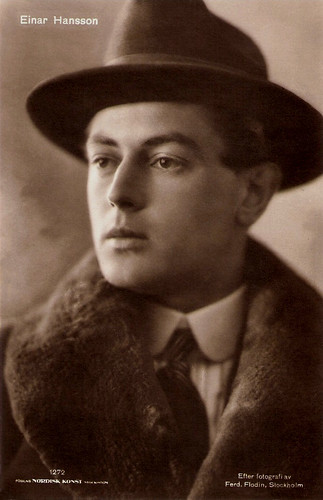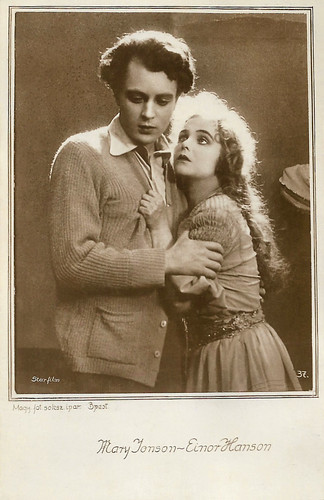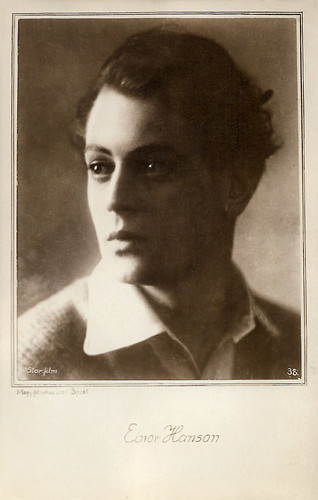Handsome and sophisticated Swedish film actor Einar Hanson (1899-1927) was a popular star of the silent film era, first in Europe, later in the US. In 1927 he was ideally positioned to take over from the late Rudolph Valentino as Hollywood's ‘great screen lover’, but suddenly he died tragically after a freak car accident. During his short but intense career, he had acted in 19 films in four countries.

Swedish postcard by Nordisk Konst, no. 1272. Photo: Ferd. Flodin, Stockholm.

Hungarian postcard by Magy. fot. soksz ipar., Budapest, no. 37. Photo: Star-film. Mary Johnson and Einar Hanson in Gunnar Hedes saga/Snowbound (Mauritz Stiller, 1923).

Hungarian postcard by Magy. fot. soksz ipar., Budapest, no. 38. Photo: Star-film. Einar Hanson in Gunnar Hedes saga/Snowbound (Mauritz Stiller, 1923).

Danish postcard by Alex. Vincent's Kunstforlag, Kobenhavn (Copenhagen), no. 18. Photo: Nordisk. Einar Hanson in Fra Piazza del Popolo/Mists of the Past (A.W. Sandberg, 1925).

Swedish postcard by Ljunggrens Konstförlag, Stockholm, no. 413. Photo: Hard, Stockholm.
Einar Hanson (sometimes credited as Einar Hansson of Hansen) was born in Stockholm, Sweden in 1899. He had no formal theatre education but began directly with minor roles at several travelling stage companies, a common occurrence around 1920. Hanson made his film debut in a bit part in Hemsöborna/The People of Hemso (Carl Barcklind, 1919), based on a play by August Strindberg.
He was discovered when he worked at Dramaten, Stockholm's Royal Dramatic Theatre, by Finnish-born director Mauritz Stiller, who according to rumour had more than a professional relationship in mind. Stiller cast him as the title character of Gunnar Hedes saga/Snowbound (Mauritz Stiller, 1923), based on the novel by Selma Lagerlöf.
Stiller had the title role first offered to Lars Hanson - who shared last names but was not related to Einar - but Stiller found him too virile for the role, a young man who prefers to play the violin and who suffers from memory loss after being injured in a blizzard. Einar Hanson with his soft, sensitive appearance fitted better.
Gunnar Hedes saga was the big breakthrough for Hanson and he went on to play leading parts in Mälarpirater/Pirates on the Malonen (Gustaf Molander, 1923), and Johan Ulfstjerna/Human Destinies (John W. Brunius, 1923). In early 1924, Stiller had a big success with Gösta Berling Saga. Shortly after, he signed a contract with the largest German film company at the time, Trianon A.G. for two films.
He started production in December 1924 on a film version of the novel, Odalisken från Smoln/The Odalisque from Smolensk by Vladimir Semitjov, in Istanbul, Turkey. His other protegee Greta Garbo would play the female leading role, Einar Hanson was her film lover, and Conrad Veidt was the villain. But Trianon went bankrupt and the project was stopped after only three weeks. Stiller sold Garbo’s contract to director Georg Wilhelm Pabst for Die Freudlose Gasse/A Joyless Street (G.W. Pabst, 1925). Einar Hanson also played a small part in this film classic.

Spanish minicard in the Series Escenas Selectas de Cinematografia. Einar Hanson and Mary Johnson in Gunnar Hedes saga/Snowbound (Mauritz Stiller, 1923). While Pauline Brunius plays in this film Hede's (Einar Hanson) mother, she is not the woman on this card. NB Hanson's name is misspelled as Hansson. The Spanish title of the film is Contra soberbia [Against Pride].

German postcard by Ross Verlag G.m.b.H., Berlin. Photo: Sofar-Film-Produktion. Einar Hanson and Mario Cusmich in Die freudlose Gasse/The Joyless Street (Georg Wilhelm Pabst, 1925). The postcard contains a stamp of Kino-Palast Zittau.

German postcard by Ross Verlag, no. 955/1, 1925-1926. Photo: Richard Oswald-Film A.G, Berlin.

German postcard by Ross Verlag, no. 955/2, 1925-1926. Photo: Richard Oswald-Film A.G., Berlin.

Austrian postcard by Iris Verlag, no. 757. Photo: Lux-Film. Einar Hanson in Fra Piazza del Popolo/Mists of the Past (A.W. Sandberg, 1925).
In the summer of 1925 Einar Hanson, Stiller and Garbo travelled to Hollywood. At Universal Studios, Hanson starred opposite the ‘Orchid Lady’ Corinne Griffith in Into Her Kingdom (Sven Gade, 1926), and opposite another screen diva, Laura La Plante in the comedy Her Big Night (Melville W. Brown, 1926).
Fan mail began pouring in and Hansen was promised bigger and better things to come by Paramount, which had bought his original five-year contract from Universal. He showed great progress in The Woman on Trial (Mauritz Stiller, 1927) and Barbed Wire (Rowland V. Lee, 1927) both starring Pola Negri.
That same year, he also appeared in The Lady in Ermine (James Flood, 1927) with Corinne Griffith, The Masked Woman (Silvano Balboni, 1927) with Anna Q. Nilsson, Fashions for Women (Dorothy Arzner, 1927) with Esther Ralston, and Children of Divorce (Frank Lloyd, Josef von Sternberg, 1927) opposite Clara Bow and Esther Ralston.
On 3 June 1927, Einar Hanson was on his way home from having dinner with Stiller and Garbo when his car apparently skidded off the road on the Pacific Coast Highway near Topanga Canyon. He died on the way to the hospital.
Barry Paris, in his 1995 biography Garbo says that Hanson met Garbo and Stiller at a party where Hanson became intoxicated and drove off on his own, leading to the fatal accident. When the crew of a tow truck came across Hanson's overturned car, they found him beneath the wreck pinned to the steering wheel, with his pet Airedale standing guard. It was too late. The actor passed away four hours later at a Santa Monica hospital with his loyal pet still at his side. Einar Hanson was only 27.

German postcard by Ross Verlag, Berlin. Photo: Alex Binder, Berlin.

Finnish postcard, Helsinki, no. 461.

Swedish postcard by Ljunggren's Könstforlag, Stockholm, no. 507. Photo: Gösta Härd, Stockholm.

Swedish postcard by Arvid Ljunggrens Konstförlag, Stockholm, no. 567.

Swedish postcard by Alex Vincents Konstförlag, no. 73.
Sources: Wikipedia, Hans J. Wollstein (AllMovie - page now defunct), Bengt Forslund (The Swedish Film Database), GarboForever, and IMDb.
This post was last updated on 4 August 2024.

Swedish postcard by Nordisk Konst, no. 1272. Photo: Ferd. Flodin, Stockholm.

Hungarian postcard by Magy. fot. soksz ipar., Budapest, no. 37. Photo: Star-film. Mary Johnson and Einar Hanson in Gunnar Hedes saga/Snowbound (Mauritz Stiller, 1923).

Hungarian postcard by Magy. fot. soksz ipar., Budapest, no. 38. Photo: Star-film. Einar Hanson in Gunnar Hedes saga/Snowbound (Mauritz Stiller, 1923).

Danish postcard by Alex. Vincent's Kunstforlag, Kobenhavn (Copenhagen), no. 18. Photo: Nordisk. Einar Hanson in Fra Piazza del Popolo/Mists of the Past (A.W. Sandberg, 1925).

Swedish postcard by Ljunggrens Konstförlag, Stockholm, no. 413. Photo: Hard, Stockholm.
Mauritz Stiller
Einar Hanson (sometimes credited as Einar Hansson of Hansen) was born in Stockholm, Sweden in 1899. He had no formal theatre education but began directly with minor roles at several travelling stage companies, a common occurrence around 1920. Hanson made his film debut in a bit part in Hemsöborna/The People of Hemso (Carl Barcklind, 1919), based on a play by August Strindberg.
He was discovered when he worked at Dramaten, Stockholm's Royal Dramatic Theatre, by Finnish-born director Mauritz Stiller, who according to rumour had more than a professional relationship in mind. Stiller cast him as the title character of Gunnar Hedes saga/Snowbound (Mauritz Stiller, 1923), based on the novel by Selma Lagerlöf.
Stiller had the title role first offered to Lars Hanson - who shared last names but was not related to Einar - but Stiller found him too virile for the role, a young man who prefers to play the violin and who suffers from memory loss after being injured in a blizzard. Einar Hanson with his soft, sensitive appearance fitted better.
Gunnar Hedes saga was the big breakthrough for Hanson and he went on to play leading parts in Mälarpirater/Pirates on the Malonen (Gustaf Molander, 1923), and Johan Ulfstjerna/Human Destinies (John W. Brunius, 1923). In early 1924, Stiller had a big success with Gösta Berling Saga. Shortly after, he signed a contract with the largest German film company at the time, Trianon A.G. for two films.
He started production in December 1924 on a film version of the novel, Odalisken från Smoln/The Odalisque from Smolensk by Vladimir Semitjov, in Istanbul, Turkey. His other protegee Greta Garbo would play the female leading role, Einar Hanson was her film lover, and Conrad Veidt was the villain. But Trianon went bankrupt and the project was stopped after only three weeks. Stiller sold Garbo’s contract to director Georg Wilhelm Pabst for Die Freudlose Gasse/A Joyless Street (G.W. Pabst, 1925). Einar Hanson also played a small part in this film classic.

Spanish minicard in the Series Escenas Selectas de Cinematografia. Einar Hanson and Mary Johnson in Gunnar Hedes saga/Snowbound (Mauritz Stiller, 1923). While Pauline Brunius plays in this film Hede's (Einar Hanson) mother, she is not the woman on this card. NB Hanson's name is misspelled as Hansson. The Spanish title of the film is Contra soberbia [Against Pride].

German postcard by Ross Verlag G.m.b.H., Berlin. Photo: Sofar-Film-Produktion. Einar Hanson and Mario Cusmich in Die freudlose Gasse/The Joyless Street (Georg Wilhelm Pabst, 1925). The postcard contains a stamp of Kino-Palast Zittau.

German postcard by Ross Verlag, no. 955/1, 1925-1926. Photo: Richard Oswald-Film A.G, Berlin.

German postcard by Ross Verlag, no. 955/2, 1925-1926. Photo: Richard Oswald-Film A.G., Berlin.

Austrian postcard by Iris Verlag, no. 757. Photo: Lux-Film. Einar Hanson in Fra Piazza del Popolo/Mists of the Past (A.W. Sandberg, 1925).
Universal and Paramount
In the summer of 1925 Einar Hanson, Stiller and Garbo travelled to Hollywood. At Universal Studios, Hanson starred opposite the ‘Orchid Lady’ Corinne Griffith in Into Her Kingdom (Sven Gade, 1926), and opposite another screen diva, Laura La Plante in the comedy Her Big Night (Melville W. Brown, 1926).
Fan mail began pouring in and Hansen was promised bigger and better things to come by Paramount, which had bought his original five-year contract from Universal. He showed great progress in The Woman on Trial (Mauritz Stiller, 1927) and Barbed Wire (Rowland V. Lee, 1927) both starring Pola Negri.
That same year, he also appeared in The Lady in Ermine (James Flood, 1927) with Corinne Griffith, The Masked Woman (Silvano Balboni, 1927) with Anna Q. Nilsson, Fashions for Women (Dorothy Arzner, 1927) with Esther Ralston, and Children of Divorce (Frank Lloyd, Josef von Sternberg, 1927) opposite Clara Bow and Esther Ralston.
On 3 June 1927, Einar Hanson was on his way home from having dinner with Stiller and Garbo when his car apparently skidded off the road on the Pacific Coast Highway near Topanga Canyon. He died on the way to the hospital.
Barry Paris, in his 1995 biography Garbo says that Hanson met Garbo and Stiller at a party where Hanson became intoxicated and drove off on his own, leading to the fatal accident. When the crew of a tow truck came across Hanson's overturned car, they found him beneath the wreck pinned to the steering wheel, with his pet Airedale standing guard. It was too late. The actor passed away four hours later at a Santa Monica hospital with his loyal pet still at his side. Einar Hanson was only 27.

German postcard by Ross Verlag, Berlin. Photo: Alex Binder, Berlin.

Finnish postcard, Helsinki, no. 461.

Swedish postcard by Ljunggren's Könstforlag, Stockholm, no. 507. Photo: Gösta Härd, Stockholm.

Swedish postcard by Arvid Ljunggrens Konstförlag, Stockholm, no. 567.

Swedish postcard by Alex Vincents Konstförlag, no. 73.
Sources: Wikipedia, Hans J. Wollstein (AllMovie - page now defunct), Bengt Forslund (The Swedish Film Database), GarboForever, and IMDb.
This post was last updated on 4 August 2024.
No comments:
Post a Comment